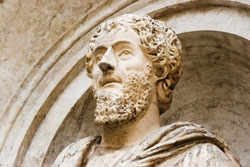RE:
SEARCH
Deciphering Plato’s puzzles
Philosophy Assistant Professor Miriam Byrd's research on an ancient Greek philosopher could change the way educators in many fields teach their students. Her project, funded by a UT Arlington Research Enhancement Program Grant, focuses on developing a new method for reading Plato's dialogues.

Dr. Byrd says the dialogues present a unique blend of literature and philosophy that engages readers and encourages them to think. She suspects that Plato created an active learning model, provoking questions and encouraging learning. He emphasized the importance of puzzles in the learning process by using "summoners."
In Plato's Republic, Socrates, Plato's teacher and a main character in his writings, specifically says summoners are perceptions that appear to be contradictory and thus provoke thought. Summoners lead individuals to transition from blindly trusting perceptions to philosophical investigation.
Byrd believes that Plato used inconsistencies between Socrates' statements within a single dialogue, inconsistencies between a character's words and actions, and obviously fallacious arguments as summoners.
"I view the dialogues as intentional puzzles," she said. "They were created for the purpose of summoning readers from passive acceptance of Socrates' words to active thought and reasoning."
Most philosophical texts are written as treatises in straightforward fashion, similar to classroom teachings of the 21st century. But Plato used dramatic forms involving multiple speakers, none of whom was Plato himself, Byrd said. She believes he intentionally placed summoners in most of his works to create learning opportunities.
Modern philosophers typically interpret Plato's writings from within the framework of two basic approaches, both of which assume that he viewed learning as passive.
The most common assumes that he presented his readers with doctrine in a straightforward fashion and that literary and contextual elements are accidental. Socrates serves as Plato's mouthpiece under this approach. The rival school of interpretation treats the dialogues as dramatic works and denies that they contain philosophical doctrine. These scholars insist that Plato meant to teach broad, dramatic lessons through Socrates' actions.
Both present inconsistencies, said Byrd, who hopes to substantiate a third approach by focusing on summoner use.
"Summoners are useful," she said. "They force thinking and learning. That's a valuable tool in any classroom."
Byrd, who joined the UT Arlington faculty in fall 2005, recently published four articles and book chapters about Plato and currently has papers under peer review. Last summer the Journal of the History of Philosophy published her paper introducing the summoner method of interpreting Plato's middle dialogues.
— Jenny Blankenship
Other Stories
Former cadets Irish, Schneider join military hall
Mavericks Personified: The 440 Alliance
Innovative band of alumni disturbs the peace with 16 strings (and drums)
Cradle of ingenuity
Wireless sensors aim to prevent sudden infant death syndrome
Strokes of genius
Golf team earns first top-20 ranking after record-setting fall season
Computer evolution
University’s early models contained no data storage devices
Contact Us
Office of University Publications
502 S. Cooper St.279 Fine Arts Building
Box 19647
Arlington, TX 76019-0647
